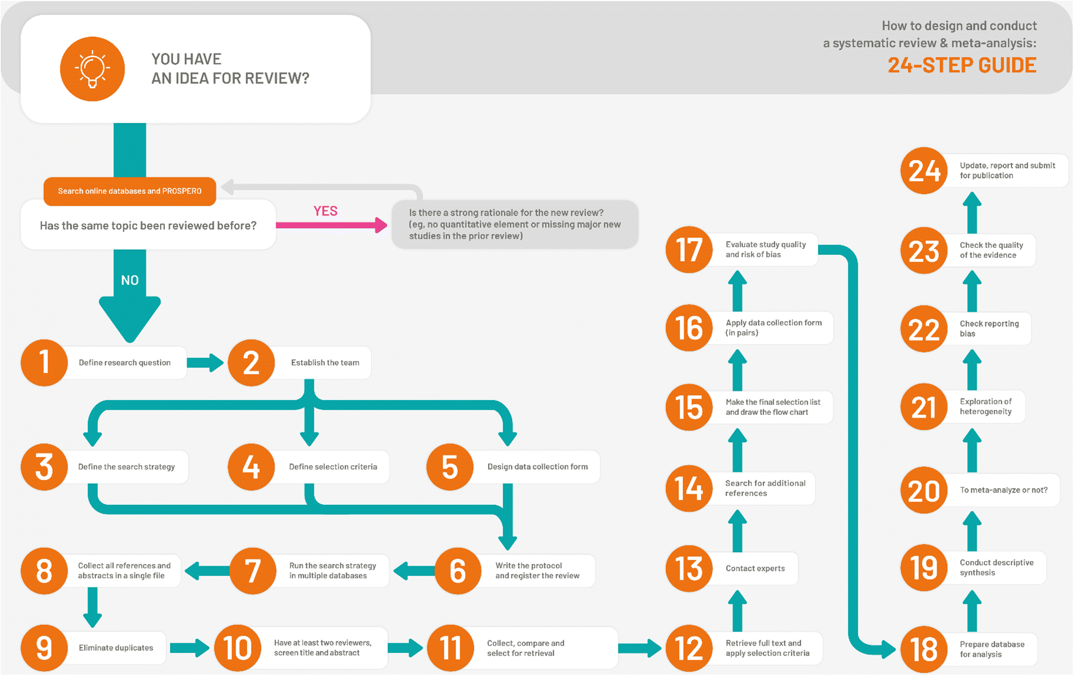2 Seminar One

How to design and conduct a systematic review - 24 step process
In the lecture this week you will have learnt about the 24 step process of performing a systematic review. You might recall that in order to develop an effective search strategy we must first determine the topic/focus of the review and formulate a research question. This is not too dissimilar to the first step you took last year when producing your literature/narrative review.
It is important to understand the fundamental difference between planning and conducting a literature/narrative review and planning and conducting a systematic review. The next task will help you identify these differences.
2.1 Task 1
Download the articles below onto your own Onedrive and open them in a pdf reader (such as, Adobe Acrobat). Once you have read both highlight, using the pdf highlighter tool, the major differences in the systematic review article.
- Hu, S., Tucker, L., Wu, C., & Yang, L. (2020). Beneficial effects of exercise on depression and anxiety during the Covid-19 pandemic: a narrative review. Frontiers in psychiatry, 11, 1217.
- Hu, M. X., Turner, D., Generaal, E., Bos, D., Ikram, M. K., Ikram, M. A., … & Penninx, B. W. (2020). Exercise interventions for the prevention of depression: a systematic review of meta-analyses. BMC public health, 20(1), 1-11.
As a group discuss why these difference might be important and how they influence your interpretation of the finding of the review
2.2 Task 2
Next, you will begin to formulate your systematic review question (assessment). The driving factor for this is usually the intervention (e.g., K-tape, variable resistance training, massage, cryotherapy etc.), however you can use the population (e.g., athletic, sedentary, injured, disease etc.) and/or outcome measure (e.g., vertical jump height, 60m sprint time, joint range of motion etc.) if this is of greatest interest.
Start by thinking of an area of your discipline that you are interested in, it might be a particular practice/intervention, clinical presentation/injury, or outcome.
Now perform a naive search of the academic databases and start to read around the topic. Make notes on what has been done, who it has been done with, what they measured, and how confident you can be in the research. The more you read around the topic the more you will be able to refine your research question, as well as understand the background/context of the topic. Win, Win!
2.3 Task 3
Formulate your research question using the template below:
A systematic review exploring the effectiveness of [intervention 1] [compared to [intervention2/control]] on [primary outcome measure] in [study population]
2.4 Task 4
Using your research question, and your search strategy knowledge from last year, perform a naive search of the academic databases to identify whether there are enough papers to synthesis, but that the question is not so broad that the review would be overwhelming to undertake.
2.5 Task 5
Many of the tasks in a systematic review need to be independently performed by two or more researchers in order to reduce possible bias. Identify someone in your class who is willing to act as an independent researcher on your review. N.B., it is expected that you will act as an independent researcher on one of your classmates projects too.
2.6 Task 5
Download and save the PRISMA systematic review protocol template to your own student Onedrive. This will be an important document over the coming weeks as your start to plan your own review. Transfer the relevant information from the tasks above to your protocol.
2.7 Additional reading
Riva, J. J., Malik, K. M., Burnie, S. J., Endicott, A. R., & Busse, J. W. (2012). What is your research question? An introduction to the PICOT format for clinicians. The Journal of the Canadian Chiropractic Association, 56(3), 167.
Thabane, L., Thomas, T., Ye, C., & Paul, J. (2009). Posing the research question: not so simple. Canadian Journal of Anesthesia/Journal canadien d’anesthésie, 56(1), 71-79.